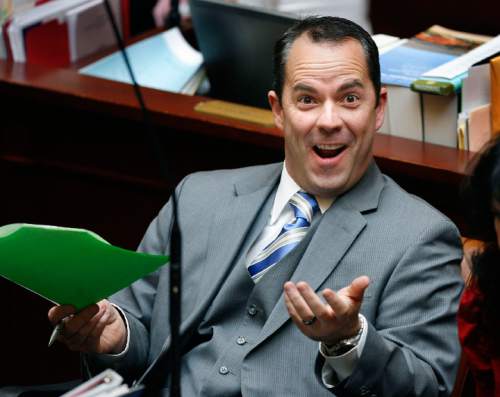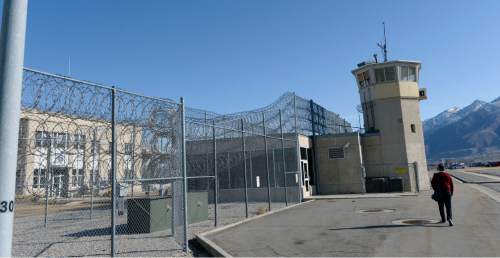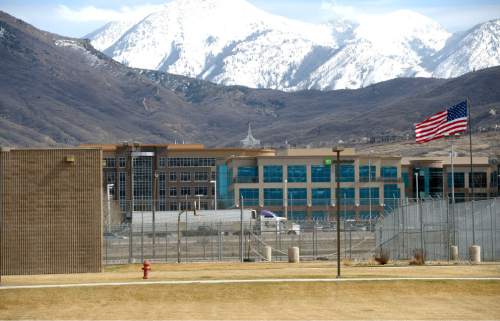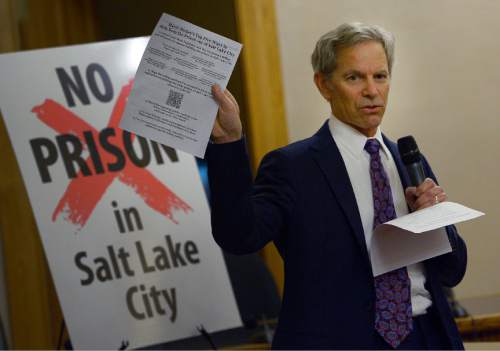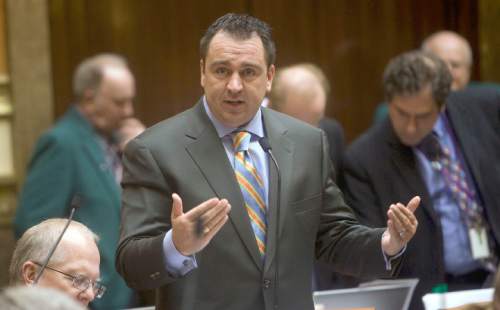This is an archived article that was published on sltrib.com in 2014, and information in the article may be outdated. It is provided only for personal research purposes and may not be reprinted.
It's possible that the Utah State Prison isn't going anywhere.
Sure, the state Legislature has said it's time to move the penitentiary out of Draper, and Gov. Gary Herbert put money in his budget to do just that. The state has even spent more than $1 million on consultants assigned to find a site for a new state-of-the-art prison, leading to weeks of protests from cities that have found themselves on the short list.
But the Legislature expressly prohibited the state from actually buying land, signing construction contracts or building a new lockup.
That will take another vote, and the soonest that could happen is during the legislative session starting Jan. 26. This has created an opening for a group of relocation opponents, many of whom are concerned that the prison could be heading to their backyards.
"I think the prison ought to stay exactly where it is at," said Grantsville Mayor Brent Marshall, who is upset at a potential location outside of his city. "If they need to build new buildings, then build it there."
Taylorsville Mayor Larry Johnson agrees. As does Charlie Luke, chairman of the Salt Lake City Council, who questions the argument that moving the prison will lead to a rush of economic development in Draper.
"What is the point? Why are we doing this?" he asks, standing just feet away from a sign saying "Leave the priz where it is." Luke had just finished leading a press conference opposing two possible prison sites in the city. He said if the state is looking for a place that can attract big businesses, why not steer them to land near the Salt Lake City International Airport, instead of trying to put the prison out there.
—
Leave it be • Or what about attractive business sites in Lehi or West Jordan or Eagle Mountain? says Stephanie Gricius, a founding member of the Keep it in Draper group, which is using Facebook to rally opponents to any relocation effort.
"The reality of it is that Utah is a business-friendly state and those businesses are going to come to Utah where they can locate in Draper or not," said Gricius, an Eagle Mountain resident who got involved because she doesn't want to see a prison moved to Utah County.
Now she doesn't want to see it moved anywhere, saying that taxpayers will have to pay a big upfront bill. Consultants say the state would be on the hook for $1 billion to construct and operate a new prison over the next 20 years.
Gricius is not alone. A new UtahPolicy.com poll conducted in the days after the state's six potential sites were identified found that 55 percent of Utahns want to leave the prison in Draper, while 36 percent want it moved.
Rep. Brad Wilson, R-Kaysville, has heard these arguments before and he finds them unconvincing. The poll didn't sway him either. As a co-chairman of the Prison Relocation Commission, he acknowledges that the Legislature hasn't made the final call on moving the prison yet, but he fully expects that to happen.
"I am more firmly resolved to move the prison now than I have ever been," Wilson said. "It is the right thing to do for the state, right thing to do for taxpayers and absolutely the right thing to do for the Department of Corrections."
He has studied the issue for the last few years. He believes moving the prison will not only open up 680 acres of prime developable land in Draper — which could be turned into a massive business park — but it will also allow the state to construct a new, more efficient penitentiary at a site on the fringe of the state's metro area instead of in its center.
—
The long view • And while it will take some upfront investment, and maybe some borrowing, the Legislature shouldn't fixate on the immediate costs, he said. Rather, it should look at the projected economic benefits, which consultants have put at $1.8 billion per year once the Draper site is fully developed years down the road.
"You don't get long term sustainable prosperity by taking the short view," said Wilson, a developer by trade who has constructed homes in Draper, but works primarily in South Jordan's Daybreak area.
The current prison has some aging buildings and it'll cost an estimated $250 million to retrofit it. Supporters of moving the prison, like Wilson, say if the state is going to have to front that money, it should spend it on a new building better suited for modern corrections practices.
Draper Mayor Troy Walker seconds that idea. He's salivating at the thought of turning the prison site into big corporate office buildings full of high-paying jobs. No decisions have been made about what to do with the Draper site if the prison moves or who would be involved in that development.
Walker has his own ideas and he's prepared with a stack of statistics and reports to show why erecting major office buildings would benefit the whole state. But he also has a more emotional argument.
"We have done our bit for king and country," he said, quoting a line from the movie "Star Trek VI: The Undiscovered Country."
"I don't believe Draper should have to bear the burden forever."
Walker notes the state moved the prison from Salt Lake City's Sugar House neighborhood in 1951, in part because of encroaching development.
"I want the prison to be located in the best possible site, where it, one, can function as a prison and, two, where it doesn't need to be rebuilt again," he said.
Draper is represented in the House of Representatives by Greg Hughes, the incoming House speaker, and a driving force behind the Prison Relocation Commission. Hughes has said he wants a new prison built where development can't encroach on all sides, whether that means near a mountain, a lake or some uninhabitable land.
—
New sites • Hughes has been unimpressed with the first six sites identified for a detailed analysis. That included sites in West Jordan and Saratoga Springs that have been dropped because the landowners withdrew them from consideration.
The remaining sites include one in Eagle Mountain, one next to the Miller Motorsports Park in Tooele County and two near the airport in Salt Lake City. Hughes, Wilson and other commissioners are on the hunt for other potential locations, and have received some proposals to move it farther out in Tooele County.
The commission will hold its next meeting on Monday, where it is expected to alter the sites on its short list. Two hours before that meeting, opposition groups from the cities now under consideration will rally on the Capitol steps. Each of these groups, representing Tooele County, Salt Lake City, West Jordan and a combined one for Eagle Mountain and Saratoga Springs has sought to fight the prison relocation without pointing fingers at one another.
They don't want this to become a battle between cities, but that hasn't stopped many of these upset residents from questioning whether the prison should move at all.
Gricius knows changing the Legislature's mind may be difficult. "But I think we definitely have a chance. ... We are not fighting city by city, so the city of Draper and the developers can profit."
Twitter: @mattcanham —
Up next
The state Prison Relocation Commission meets at 2 p.m. Monday in the Senate Building, Room 201. The Senate Building is to the northeast of the State Capitol. Opponents to proposed new prison sites will rally at noon on the State Capitol steps.


